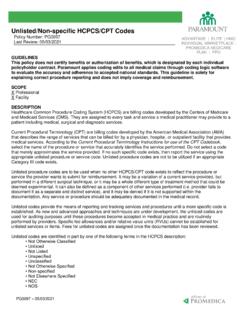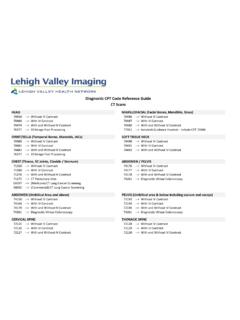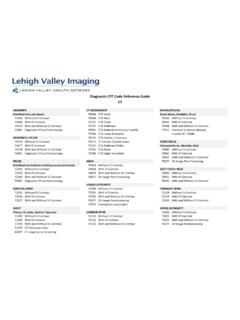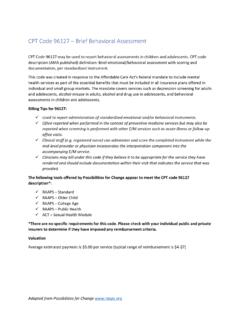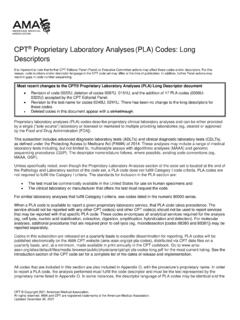Transcription of 15 CPT & Coding Issues for Orthopedics and Spine ASC ...
1 15 CPT & Coding Issues for Orthopedics and Spine ASC Facilities Speaker Stephanie Ellis, , CPC 256 Seaboard Lane, Suite C-103 Franklin, TN (615) 371-1506 Presented for 10th Annual Orthopedic, Spine & Pain Management-Driven ASC Conference by ASC Communications, Inc. & ASCA 2012 CPT Codes are Copyrighted by the AMA June 2012 2 Procedure for Sequencing CPT Codes on claim forms for surgical procedure(s) performed in Freestanding ASC Facilities for the ASC facility: 1. Review the entire OP Report(s) for the surgical case. 2. Code out the CPT procedure code(s) for all surgical procedures performed. 3. Look up each pertinent CPT procedure code(s) with all of the other pertinent CPT procedure code(s) in the CCI material to determine Unbundling for the case. 4. Determine if those procedures designated as Separate Procedures in the CPT book and those CPT codes which are Unbundled in the CCI material are billable using the -59 Modifier or they should not be billed.
2 Arrive at the final CPT procedure code(s) that can be billed for the surgery(s) performed. 5. Look up each CPT code to be billed to Medicare on the Medicare ASC List for the associated fee. 6. Sequence the CPT codes for billing from Highest to Lowest Fee listed on the Medicare ASC List. 7. For payors other than Medicare with whom the ASC has a contract and the payor goes by Payment Groupers, sequence the CPT codes on claims from Highest to Lowest Payment Grouper regardless of the ASC facility s fee schedule amount. 8. For payors other than Medicare with whom the ASC does not have a contract OR the payor does not go by Payment Groupers, sequence the CPT codes on claims from Highest to Lowest RVU weight regardless of the ASC facility s fee schedule amount. 9. For Medicare cases, those CPT codes to be billed which are NOT listed on the Medicare ASC List or have to be billed using an Unlisted CPT code are not covered by the Medicare program and should be billed using the GY or GZ Non-Covered Modifier in the last position on the claim form.
3 SPECIAL Coding GUIDELINES Bilateral Procedures Physician practices don t have as many rules to go by for billing Bilateral Procedures as do ASC facilities. All providers need to inquire about payor requirements and follow them, if they do have specific rules about modifier usage. If a surgical procedure is by (CPT) definition unilateral, and is performed bilaterally, the provider should report the CPT code on the claim form in a bilateral manner. The policies each payor has for the use of modifiers for reporting bilateral procedures can vary widely, so the ASC facility should check with each payor to which they submit claims for their preferred method of billing Bilateral procedures. Modifier 50 identifies a procedure performed identically on the opposite side of the body (mirror image). Some payors prefer the use of the RT Anatomic Modifier on one code and the LT Modifier on the other. Don t mix the use of -50 and RT or LT Modifiers on the same code.
4 Be consistent in the method used for claims going to a particular payor. If the surgical code is by definition bilateral, the CPT procedure code is reported once (with no modifier), even if the procedure is performed on both sides. If the procedure is often performed bilaterally, but is performed only CPT Codes are Copyrighted by the AMA June 2012 3 unilaterally for a surgery, the usual fashion is to bill using an RT or LT Modifier on the CPT code. The five usual methods for the billing of Bilateral procedures for ASC facilities include: Bill the same code as two line items, using the RT Modifier on one code and the LT Modifier on the other (same) code. (**Medicare) o 64483-RT $ o 64483-LT $ Bill the bilateral procedures as two line items with no Modifier on the 1st code and a 50 Modifier on the 2nd line item (same code). o 64483 $ o 64483-50 $ Bill the procedure as a single line item on the claim form with a 50 Modifier on the procedure code.
5 Be sure if you use this method to double the facility fee. o 64483-50 $1, Bill the same code as two line items with no Modifiers. (**Medicare) o 64483 $ o 64483 $ Bill the procedure as a single line item on the claim form with no Modifier on the procedure code and put a 2 in the Units column on the claim. Be sure if you use this method to double the facility fee. (**Medicare) o 64483 2 Units $1, **Billing methods allowed on Medicare ASC claims. Do NOT use the -50 Modifier on Medicare claims, unless your Medicare MAC specifically requires you to do so. Add-on Codes For some multiple procedures, Add-on codes should be used, when required. Add-on codes are identified with a + notation. These can be seen in Pain Management claims for Injections done at subsequent levels. Do not list an Add-on code first on the claim form. List the code for the main procedure/first level procedure first, followed by the subsequent level Add-on codes.
6 Separate Procedures Those procedures designated as Separate Procedures in the CPT book must be treated differently from other procedures. If these procedures are not coded and billed correctly, the facility can experience a denial from the payor similar to a CCI Unbundling denial even if the codes are not Unbundled in the CCI Unbundling material. A Separate Procedure , by definition, is a component of a more complex service and is usually not identified separately. These services are typically an integral component of a more extensive service. When these services are performed alone, or not as part of a larger or more inclusive procedure, then the separate procedure should be reported. When the separate procedure is carried out independently or distinctly from other procedures, it may be reported by itself or with the -59 modifier, in some instances ( , separate site or CPT Codes are Copyrighted by the AMA June 2012 4 by a separate incision).
7 The separate procedure designation indicates that a certain procedure or service may be: Performed independently; Unrelated or distinct from other procedure(s)/service(s) provided at that time; or Considered an integral component of another procedure/service. Codes designated as Separate Procedures may be billable with the use of the 59 modifier, to indicate that the procedure is not considered a component of another procedure, but a distinct, independent procedure, such as the following: Different session or patient encounter; Different site or organ system; Separate incision/excision; Separate compartment; OR Separate lesion Unbundling of CPT Codes To define, Unbundling is the practice of breaking out each individual part of a procedure and billing for it separately. This is most frequently done with surgical procedures. It is an unethical practice. Unbundling is to be avoided, as it can flag an audit from a payor. The individual components, or incidental services of a surgical package, should not be coded when the primary procedure code includes these components.
8 This is referred to as Unbundling. To avoid Unbundling, check each procedure code to be billed with every other procedure code to be billed in the current CCI Unbundling material to see if any of them are components of another code. Pay close attention to code selection by Coding with the most accurate and complete code available for use, using CPT guidelines. If there is a doubt, check with the physician as to what the main procedure is and what might be included. In some (very few) cases, even though one code is Unbundled from another listed procedure, it can be billed anyway using a 59 Modifier. If the procedure was done in a separate area, by a separate incision, etc., it might be billable. Check the OP Note and the procedure book descriptions carefully, assess correct modifier usage, and contact the Medical Review or Coding department at the payor for guidance. This situation would not occur very often. Usually, if it is Unbundled, it is not billable.
9 CPT Codes are Copyrighted by the AMA June 2012 5 15 CPT & Coding Issues for Orthopedic and Spine ASC Facilities 1. Lipoma Removals Lipomas are benign fatty tumors in the subcutaneous or deeper tissues. They are tumors arising in soft tissue areas. They can occur on the chest, back, flank, neck, shoulder, arm, hand, wrist, fingers, hip, pelvis, leg, ankle, or foot. Lipomas can be of varying depth into the tissues, which is what dictates how you code their removal. While there are diagnosis codes for Lipomas ( section), there are no specific CPT procedure codes for Lipoma Excisions. Lipomas can be as superficial as the subcutaneous tissue or extend deep into the intramuscular tissues. Therefore, it is very important to code these accurately using the appropriate code from the 10000-section (11400-11446), if the Lipoma is located in the subcutaneous tissues, or Coding from the 20000-section codes, if the lipoma is removed from subcutaneous tissue and a layered closure is performed or the lipoma is removed deep from subfascial or intramuscular tissue area.
10 2. Joint Injections Use code 20600 for an Arthrocentesis, aspiration and/or injection; small joint or bursa (eg, fingers, toes). Use code 20605 for an Arthrocentesis, aspiration and/or injection; intermediate joint or bursa (eg, temporomandibular, acromioclavicular, wrist, elbow or ankle, olecranon bursa). Use code 20610 for an Arthrocentesis, aspiration and/or injection; major joint or bursa (eg, shoulder, hip, knee joint, subacromial bursa). Use this code if an SI Joint Injection is done without any imaging (instead of 27096 or G0260). 3. Joint Manipulations CPT guidelines are that if a surgical arthroscopy is performed on the same joint when a Joint Manipulation and/or Joint Injection are performed in the same case, only the scope procedure is billable. Shoulder Joint Manipulation code is 23700. This procedure may be performed in the same case with a Joint Injection (code 20610) on the same joint. This procedure is usually performed for Adhesive Capsulitis, for post-shoulder replacement stiffness and for frozen shoulder conditions.



